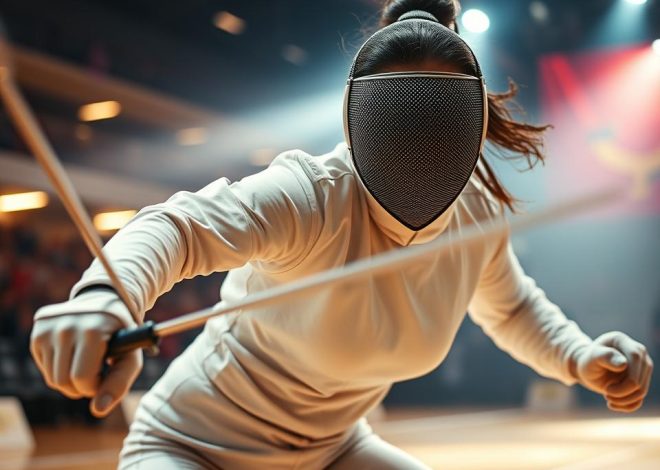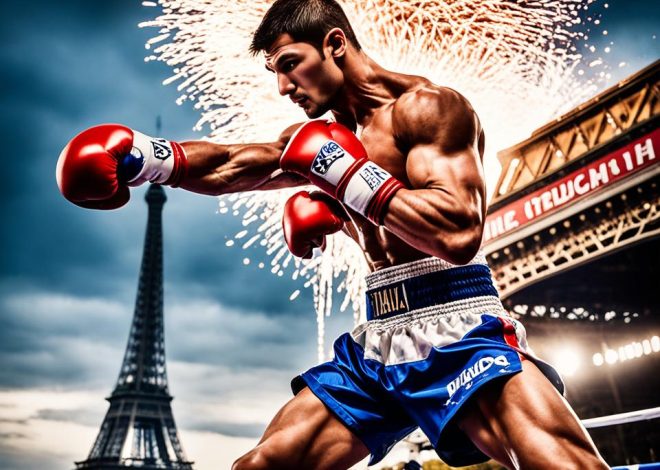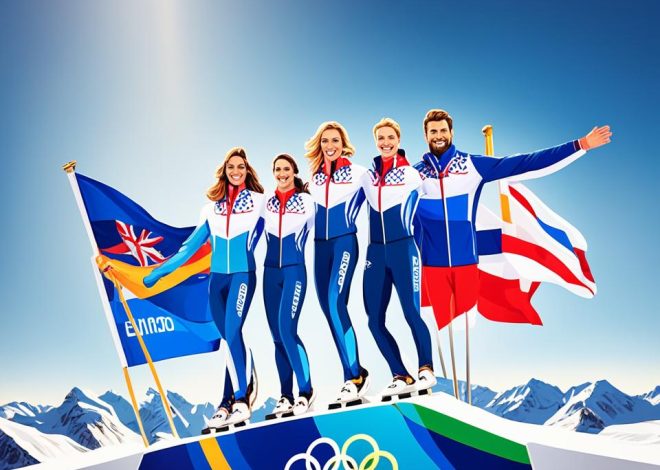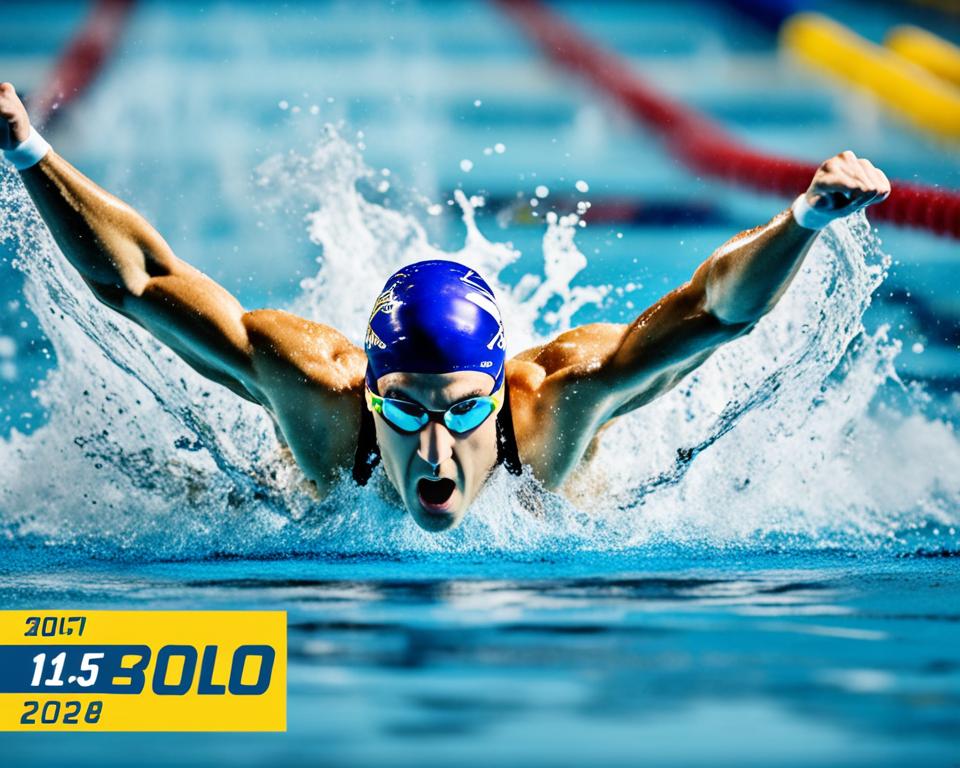
Olympic Swimming Times: World-Class Records
The world of Olympic swimming is truly captivating. It’s filled with remarkable achievements and record-breaking performances. It includes thrilling sprints and grueling long-distance races, showcasing peak human aquatic abilities. We’re diving into Olympic swimming times and their significance, the record evolution, and the events that draw global sports fans.
Swimming has always been key at the Olympics. The first swimming events debuted in 1896. The sport has since seen huge changes in both athlete technique and performance tech. Pursuing faster times and breaking records is now a core aspect, pushing athletes’ limits of endurance and skill.
The Olympic swimming events are known for their intensity and competitors’ unwavering drive. They feature lightning-fast sprints, graceful butterfly strokes, and powerful freestyle laps. From legendary swimmers to new stars ready to set records, we’re taking you through Olympic swimming times. This will give you a deep look at this captivating, ever-evolving sport.
Read more interesting information at ::mbp-tokushima
An Introduction to Olympic Swimming Times
Swimming is a well-loved event at the Olympics, going strong for over 100 years. It grabs attention all over the world with exciting races and performances that leave us in awe. Athletes keep aiming for faster times, showing us what humans are capable of. This journey has led to many incredible moments and a history full of records being broken.
Significance of Swimming at the Olympics
Swimming stands out as a top sport at the Olympics, known for its challenging nature. It requires not just physical strength but also mental toughness. The events at the Olympics highlight the best swimming abilities on earth. They draw top swimmers from everywhere to compete for the ultimate prize, a gold medal.
Evolution of Swimming Records
Swimming records have improved a lot over time, showing the sport’s steady growth. At the start of the modern Olympics, it was normal to measure records in minutes. But now, we see incredibly fast times, thanks to better techniques, training methods, and technology. Every new group of swimmers keeps raising the bar, breaking old records and setting new ones.
The journey of Olympic swimming times is a truly inspiring tale. It speaks volumes about our unyielding desire for perfection. As we look closer at the olympic swimming times and swimming records, we’ll find stories of remarkable accomplishments. These tales have firmly placed swimming as a key part of the Olympic Games.
Olympic Swimming Events
The Olympic Games show many swimming events. These have unique challenges and ways to win. Swimmers face off in different races, from fast freestyle to graceful butterfly strokes. These events make the best athletes in the world shine, showing their top-notch skills.
The heart of the Olympics is the swimming program’s individual events. Swimmers race against each other in distances from 50 to 1,500 meters. This includes freestyle, backstroke, breaststroke, and butterfly strokes. Both men and women get medals in these races.
The relay races add more excitement. Here, four swimmers join forces to swim the distances together, striving for the quickest time. These happen in the freestyle and medley types. It shows how teamwork and smart planning are crucial in the Olympic swimming scene.
| Event | Distance | Strokes |
|---|---|---|
| Freestyle | 50m, 100m, 200m, 400m, 800m, 1500m | Freestyle |
| Backstroke | 100m, 200m | Backstroke |
| Breaststroke | 100m, 200m | Breaststroke |
| Butterfly | 100m, 200m | Butterfly |
| Individual Medley | 200m, 400m | Butterfly, Backstroke, Breaststroke, Freestyle |
| Freestyle Relay | 4 x 100m, 4 x 200m | Freestyle |
| Medley Relay | 4 x 100m | Backstroke, Breaststroke, Butterfly, Freestyle |
This big mix of olympic swim events lets athletes prove how many talents they have. It turns the Olympic swimming matches into a must-watch event for both the people taking part and those watching.
“The Olympics are a wonderful metaphor for world cooperation, the kind of international competition that’s wholesome and healthy, an interplay between countries, an exchange of cultures and ideas, an opportunity to build friendships, and add understanding.”
– Francis Crick
Olympic Swimming Times: World Records
Competitive swimming stands out for its fast pace and elegance. Athletes constantly challenge what’s possible. The ultimate achievements in this thrilling sport are the world records. They set the standard of swimming excellence and motivate everyone involved.
Men’s Swimming World Records
In men’s swimming, the world records highlight amazing athleticism and skill. These records cover events like fast-paced freestyles to endurance tests. They prove a commitment to being the best.
Caeleb Dressel holds a top record in the 100-meter freestyle at 46.91 seconds. This feat was at the 2019 FINA World Championships. It shows how much swimming has progressed with better technology, training, and techniques.
Women’s Swimming World Records
Women’s swimming records also amaze with skill and determination. Events range from the quick 50-meter freestyle to the long 1500-meter freestyle.
A notable record is in the women’s 200-meter butterfly, set by Zhang Yufei at 2:03.86. She achieved this at the 2021 Tokyo Olympics. It shows the continuous improvement and push for faster times.
| Event | Men’s World Record | Women’s World Record |
|---|---|---|
| 50m Freestyle | 20.91 seconds (Cesar Cielo, Brazil) | 23.67 seconds (Sarah Sjöström, Sweden) |
| 100m Freestyle | 46.91 seconds (Caeleb Dressel, USA) | 51.60 seconds (Sarah Sjöström, Sweden) |
| 200m Freestyle | 1:42.00 minutes (Sun Yang, China) | 1:52.98 minutes (Katie Ledecky, USA) |
| 400m Freestyle | 3:40.07 minutes (Sun Yang, China) | 3:56.46 minutes (Katie Ledecky, USA) |
| 1500m Freestyle | 14:31.02 minutes (Sun Yang, China) | 15:20.48 minutes (Katie Ledecky, USA) |
The swimming records are more than just marks. They showcase the best human efforts in the water. It takes hard work and dedication to reach these levels. As swimming moves forward, we can’t wait to see more amazing feats and new records.
Factors Influencing Swim Times
Reaching record times in swimming at the Olympics depends on many things. This includes tough training, better equipment, and the latest technology. These aspects are key in how well top swimmers do on the largest global sports stage.
Training and Preparation
Success for elite swimmers begins with intense training. They spend hours perfecting their strokes and getting stronger. This hard work makes them not only physically fit but mentally ready for the extreme pressures of Olympic contests.
Equipment and Technology
The swim sport has seen big changes in gear and technology over the years. New swimsuits, starting blocks, and timing systems continually help athletes swim faster. These tools are crucial for enhancing swimming performance and setting new records.
In the Olympic swimming events, the balance between hard training and using the latest gear is vital. It leads to extraordinary performances, which the whole world watches in awe.
| Factor | Impact on Swim Times |
|---|---|
| Training and Preparation | Improves stroke technique, endurance, and mental toughness |
| Equipment and Technology | Reduces drag, enhances efficiency, and enables faster times |
Legendary Olympic Swimmers
The Olympics and its swimming events have seen the rise of many remarkable athletes. They’ve not just set new records but have also motivated countless young people. These legends showed us that with dedication, we can surpass our limits.
Michael Phelps, the most decorated Olympian, started his journey at the Sydney Olympics in 2000. There, at only 15, he earned his first gold medal. He continued to shine, gathering a total of 28 Olympic medals over his career. Among them are an incredible 23 golds.
Katie Ledecky, another Olympic star, has dominated women’s freestyle events since her debut in the London Olympics of 2012. Her talent and hard work have seen her break numerous records. Today, she stands as one of the brightest stars in Olympic swimming history.
Phelps, Ledecky, and others have inspired many young athletes. They’ve shown that with effort and dedication, we can achieve extraordinary things. Their impact on the sport goes beyond their medals. They have become living proof that hard work pays off.
| Swimmer | Olympic Medals | World Records Held |
|---|---|---|
| Michael Phelps | 28 (23 Gold, 3 Silver, 2 Bronze) | 13 |
| Katie Ledecky | 7 Gold, 1 Silver | 14 |
| Caeleb Dressel | 7 Gold | 6 |
| Simone Manuel | 4 (2 Gold, 2 Silver) | 2 |
Their stories stand witness to the extraordinary power of dedication and perseverance. They not only amazed the world with their achievements but also raised the bar for swimming’s future. Their excellence has inspired a whole new generation of swimmers.
“Swimming is normal for me. I’m relaxed. I’m comfortable, and I know my surroundings. It’s my home.” – Michael Phelps
Analyzing Swim Stroke Techniques
In chasing Olympic medals, mastering swim strokes is critical. Top athletes tweak their strokes to cut down lap times and set records. Let’s explore the strategies behind two key strokes: freestyle and breaststroke.
Freestyle Stroke
The freestyle, or front crawl, is top for both speed and efficiency. A steady arm action and solid kick keep swimmers moving smoothly.
For a great freestyle, a swimmer should stay as straight as an arrow. Their head and shoulders need to be in a line, with hips and legs following. Big arm circles and fast leg kicks power them ahead.
Breaststroke
The breaststroke stands out with its flowing, whip-like movement. Getting the arms and legs to sync just right is key. This creates a circular flow that helps maintain speed.
In the breaststroke, swimmers keep their head above water as they move forward. The whole body sculpts into a line, with arms gliding out and fins-like leg movements. This form is key to a powerful, efficient swim.
Swimmers must keep their cadence steady and controlled in the breaststroke. It’s all about keeping the momentum up to the finish line.
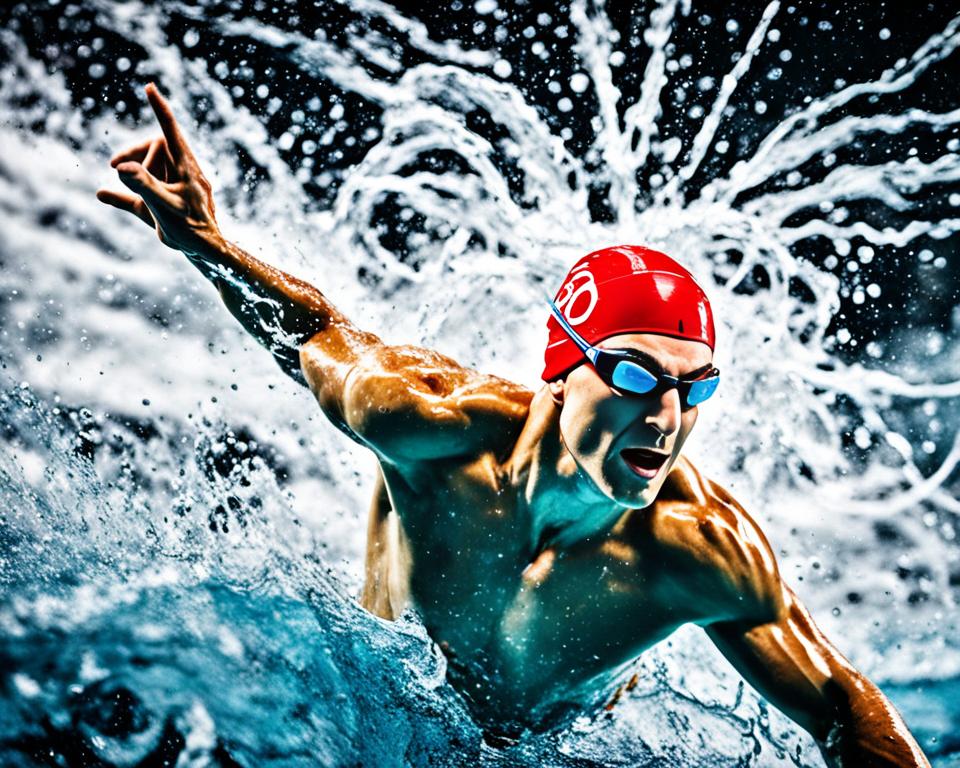
The details of a stroke can make or break a race for Olympic swimmers. By perfecting their techniques, swimmers can reach new heights and make the most of their talent.
Swimming Time Standards
In competitive swimming, meeting tough time standards is crucial. These standards act as a key to the Olympic Games. Only the fastest and most skilled swimmers earn a chance to compete on the global stage.
Olympic Qualifying Times
To enter the Olympic events, swimmers must match the times set by FINA. These times make sure only the best swimmers compete. Getting an Olympic time is tough, needing years of hard work, discipline, and a desire to be the best.
These times are set years before the Games, helping swimmers plan. They can change, but this keeps the competition strong and the skill level high each Olympics.
| Event | Men’s Qualifying Time | Women’s Qualifying Time |
|---|---|---|
| 50m Freestyle | 21.50 | 24.50 |
| 100m Freestyle | 47.90 | 53.50 |
| 200m Freestyle | 1:46.02 | 1:56.88 |
| 400m Freestyle | 3:45.20 | 4:06.80 |
| 800m Freestyle | N/A | 8:31.00 |
| 1500m Freestyle | 15:00.99 | N/A |
| 100m Backstroke | 53.85 | 59.85 |
| 200m Backstroke | 1:57.50 | 2:08.43 |
| 100m Breaststroke | 59.93 | 1:07.07 |
| 200m Breaststroke | 2:09.34 | 2:24.57 |
| 100m Butterfly | 51.96 | 57.67 |
| 200m Butterfly | 1:56.48 | 2:07.79 |
| 200m Individual Medley | 1:59.67 | 2:11.30 |
| 400m Individual Medley | 4:14.79 | 4:40.84 |
The above table shows the present Olympic times for men and women. These times set a very high standard. They prove the skill and dedication of the top swimmers in the world.
If swimmers reach these tough time standards, they can go to the Olympic swimming championships. There, they will challenge the world’s best for the ultimate prize in swimming.
The Psychology of Elite Swimming
Being a top swimmer at the Olympics isn’t just about being strong. It’s a deep mental challenge. Elite swimmers need strong minds to handle the stress of the world’s biggest competitions.
The magic of olympic swimming times comes from the stories of swimmers. These stories show how mental toughness is key. They’ve learned to keep their heads cool when all eyes are on them.
- Goal-setting: Successful swimmers set goals they can measure. They turn big dreams into small, doable steps. This makes them more focused and determined.
- Visualization: Elite swimmers imagine themselves in the race. They think about every detail – from the start to the finish. This makes them confident and ready for anything.
- Emotional control: Swimmers have to handle their feelings well. They turn nervous energy into something positive. They use tricks like deep breathing to stay calm.
- Competitive mindset: Top swimmers never stop trying to be better. They love a good challenge. They use hard times to grow stronger.
“The true test of a champion is not whether he can triumph, but whether he can overcome obstacles.” – Garth Stein, author
The mental side of elite swimming is crucial. Staying focused and calm under pressure is what makes champions stand out. Learning to master these mental skills helps swimmers win, not just in the pool but in life too.
Olympic Swimming Championships
The Olympic swimming championships are the peak of competitive swimming. They capture the world’s attention with amazing performances and record-breaking achievements. These events not only show the incredible ability of swimmers but also make history in the sport.
Historical Moments
Over their history, the Olympic swimming championships have had many unforgettable moments. From world records to legendary comebacks, each event is full of drama and thrill. These events have forever impacted sports worldwide.
- The 1972 Munich Olympics saw American swimmer Mark Spitz win seven gold medals. He set new world records in each event.
- The 2008 Beijing Olympics were marked by Michael Phelps winning eight gold medals. This achievement is the most by any athlete in one Olympics.
- At the 2016 Rio de Janeiro Olympics, Katie Ledecky dominated the women’s freestyle. She set new records and solidified her place among the best swimmers ever.
- The 2020 Tokyo Olympics, held in 2021 because of COVID-19, introduced new stars. Caeleb Dressel and Ariarne Titmus made their mark on the sport.
These iconic moments have captivated the world and motivated upcoming swimmers. They encourage athletes to always strive for excellence and greatness.
| Year | Location | Iconic Moments |
|---|---|---|
| 1972 | Munich | Mark Spitz’s 7 gold medals, 7 world records |
| 2008 | Beijing | Michael Phelps’ 8 gold medals |
| 2016 | Rio de Janeiro | Katie Ledecky’s dominance in women’s freestyle |
| 2020/2021 | Tokyo | Emergence of Caeleb Dressel and Ariarne Titmus |
These moments in the Olympic swimming championships have done more than just entertain. They’ve inspired present and future swimmers to break limits and reach for their dreams.
Controversies and Doping Scandals
The Olympic swimming world has seen its share of problems. Controversies and doping issues have caused trouble. They often question the honesty of swimming records and the spirit of the olympic swimming championships.
In 1988, the Ben Johnson case shocked everyone. He was a fast sprinter from Canada. Johnson won the 100m race at the Seoul Olympics but was later found using a banned drug. This case made everyone take a closer look at drugs in sports.
- Using drugs to perform better has troubled olympic swimming. Many swimmers have been punished for it over time.
- Some issues came up about special swimsuits. Athletes felt these suits gave an unfair edge. Afterward, some swimsuits were banned, sparking talks about tech in the sport.
- Also, more recent debates involve transgender athletes in women’s swimming. These discussions bring up tough moral and rule-making talks.
“The integrity of the sport is of utmost importance, and we must ensure that swimming records and olympic swimming championships are earned through hard work, dedication, and fair play.”
Organizations like FINA are trying to make things right. They’re putting in tougher anti-doping rules. Yet, beating doping and issues in Olympic swimming is still hard.
The olympic swimming championships draw in lots of viewers. It’s very important that the sport keeps its high respect and honesty. This way, the true heart of Olympic swimming shines through. It shows excellence, excitement in competition, and it inspires by the world’s top athletes.
The Future of Olympic Swimming
The world of Olympic swimming is becoming more exciting. It’s filled with new technology and young stars. These will change how we look at swimming in a big way.
Technological Advancements
New tech has already made a huge impact on swimming. Swimsuits and cameras make swimmers faster and more efficient. As a result, we see better swim competition times at the Olympics.
Next, we’ll see even more tech in Olympic swimming. Smart wearables and AI will help swimmers improve even more. They’ll get instant feedback and custom training programs. These tools aim to help them swim their fastest swim times ever.
Emerging Swimming Talents
New, young swimmers from everywhere are making a mark. They are passionate and determined to do well. This drive will likely break old swimming records.
These young swimmers have broken many records already. They show us that even against challenges, great success is possible. They’ll be the Olympic stars of tomorrow.
“The future of Olympic swimming is not just about the times, it’s about the stories, the dreams, and the relentless pursuit of excellence that will shape the next generation of aquatic legends.”
We are excited to see what’s next in Olympic swimming. The future looks bright with more exciting races and feats. It’s about seeing how far the human spirit can go.
Training Regimens for Competitive Swimmers
Athletes aiming to be top swimmers follow strict training routines. These push their mind and body to the limit. The goal is to enhance their competition times and perfect their swimming techniques.
Training for swimmers starts with focus on technical drills. They work on improving their freestyle, breaststroke, butterfly, and backstroke. These drills create muscle memory and make their strokes more efficient, leading to faster times.
- Competitive swimmers spend time on strength-building. This includes weightlifting and resistance training. It’s all about getting the power needed for strong swim strokes.
- Endurance is key in swimming. Swimmers do long distance swims and interval exercises. These build their stamina and heart health to keep up good times in the pool.
- Rest is just as important. Swimmers use things like yoga and stretching for active recovery. This prevents injuries and keeps them in top form.
By following these detailed training plans and focusing on nutrition and hydration, swimmers achieve extraordinary results. Their commitment to these disciplines helps them exceed normal limits in swimming.
“The pool is my sanctuary, where I can push my limits and strive for greatness. Each stroke, each lap, is a testament to the countless hours of dedication and sacrifice.”
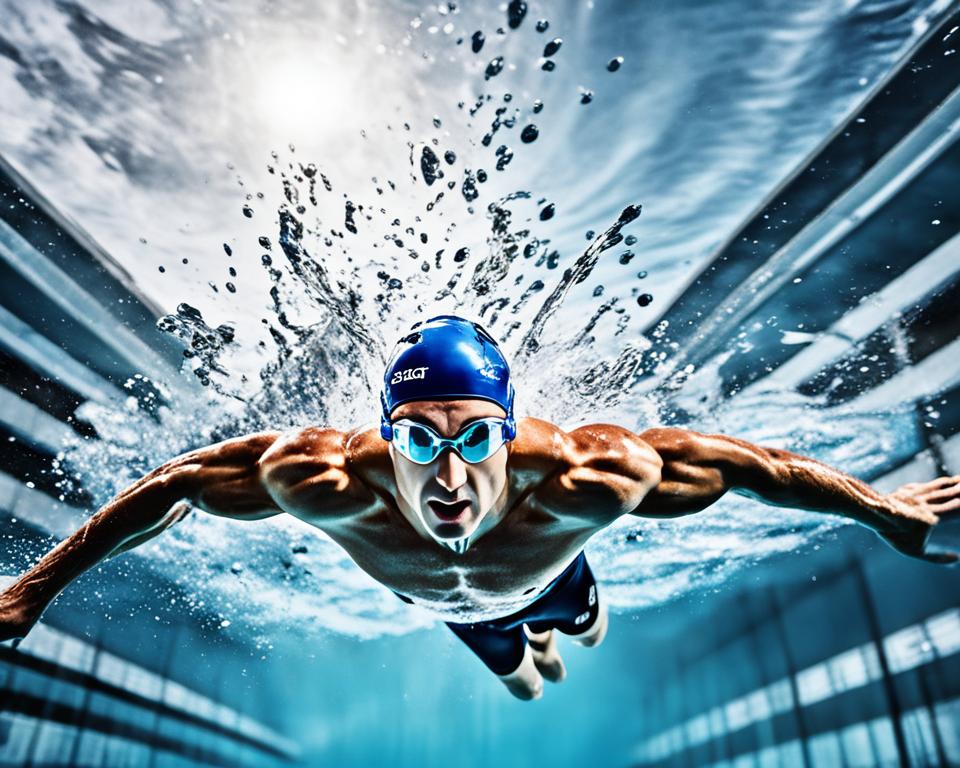
With dedicated training, competitive swimmers can break records. They set high standards for future swimmers. This excellence opens paths for others to dream big in swimming.
Olympic Swimming Venues
The Olympic Games highlight the world’s best swimming venues. Each venue tells its own story and features unique architecture. They have been home to the most important olympic swim events and olympic swimming championships.
One of the famous venues is the Tokyo Aquatics Centre. It was built for the 2020 Olympics. The center has a main pool and a warm-up pool. It can seat over 15,000 people. Many love its modern look and smart design.
The Beijing National Aquatics Center, or the “Water Cube,” is also iconic. It was the main place for swimming in the 2008 Olympics. This bubble-like building was designed to look like water. It also uses materials that are good for the environment.
| Venue | Location | Olympic Year | Unique Features |
|---|---|---|---|
| Tokyo Aquatics Centre | Tokyo, Japan | 2020 | Sleek, modern design; 50-meter competition pool, 25-meter training pool, seating for 15,000 |
| Beijing National Aquatics Center | Beijing, China | 2008 | Unique “Water Cube” design; Environmentally-conscious materials and systems |
| Olympic Aquatics Stadium | Rio de Janeiro, Brazil | 2016 | Temporary venue with retractable roof; Designed to be dismantled and repurposed after the Games |
Then, there’s the Rio Olympic Aquatics Stadium from 2016. It was made to last. With a roof that opens and a plan to reuse it after, it’s about sustainability.
All these places show the Olympic spirit. They encourage new athletes and fans for years to come.
The Impact of Olympic Swimming
Olympic swimming goes beyond exciting races and new records. It shows the world how hard work and courage pay off. These swimmers’ stories inspire others to follow their dreams.
Inspiring Future Generations
Olympic heroes like Michael Phelps and Katie Ledecky show young swimmers the power of dedication. Their stories of success teach us that with hard work, anyone can achieve their goals.
These athletes don’t just win medals; they light a fire in people’s hearts. They make communities and nations cheer for the same dream. As a result, young athletes everywhere start to believe that they too can make it to the Olympics.
